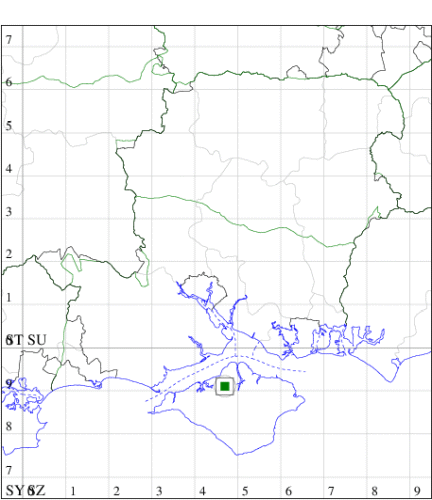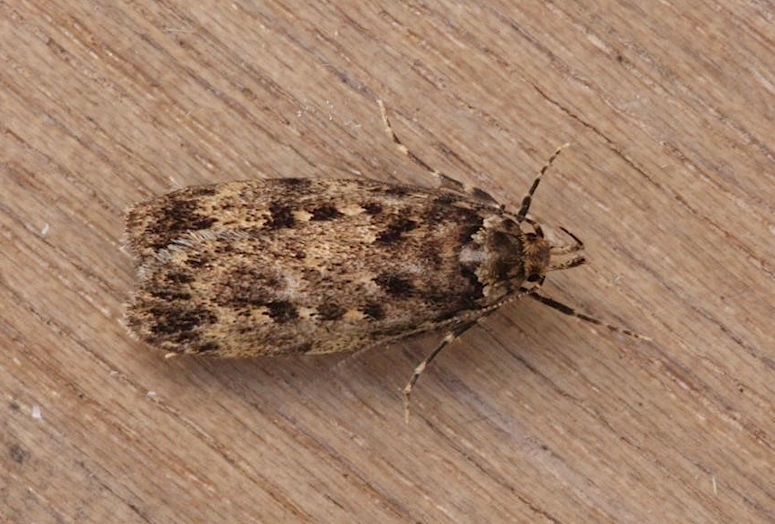Barea asbolaea
Checklist Number28.028 [B&F: 0656a]
Verification
Record will require further evidence, at least a good photograph, unless CMR is aware recorder has confidence in identification
Classification
| Family: | Oecophoridae |
| Subfamily: | Oecophorinae |
| Genus: | Barea |
| Species: | asbolaea |
| Authority: | (Meyrick, 1883) |
Naturalised through accidental introduction in garden plants, south-western England. In 2006, a moth trap operated at a garden near Buryas Bridge, Cornwall, revealed an unfamiliar Oecophoridae species that was quite unfamiliar. The moth remained a mystery for some while, but in 2008 large numbers were caught in a Penzance trap and small numbers were also caught at Crows an Wra, four miles to the west. With the help of a number of experts in Britain and abroad, identification via dissection was confirmed. Subsequently a photograph has been traced of the moth in 2004; this appears to be the earliest recorded example. It has been recorded in some numbers at the original site annually since. The particular origins of British specimens may be a local garden and nursery where antipodean plants have been imported since the late 1800s.
In July 2014 Iain Outlaw trapped a mystery oecophorid in Parkhurst Forest, Isle of Wight. In order to confirm the species it was necessary to gen. det. a male specimen to compare with the reference specimen in BMNH; however, all examples retained each year were female, until finally in July 2017 two males were collected and proved to be this species. It seems to be well established in the area, and has possibly only recently arrived, with 2014 seeing one, 2015 two, 2016 five and a big jump to 26 in 2017.
In July 2014 Iain Outlaw trapped a mystery oecophorid in Parkhurst Forest, Isle of Wight. In order to confirm the species it was necessary to gen. det. a male specimen to compare with the reference specimen in BMNH; however, all examples retained each year were female, until finally in July 2017 two males were collected and proved to be this species. It seems to be well established in the area, and has possibly only recently arrived, with 2014 seeing one, 2015 two, 2016 five and a big jump to 26 in 2017.


The abundance in each month is indicated as follows:
 No records
No records Very occasional
Very occasional Irregular
Irregular Uncommon
Uncommon Off-peak, but not unusual
Off-peak, but not unusual Off-peak, but not unusual
Off-peak, but not unusual Main flight time
Main flight time| J | F | M | A | M | J | J | A | S | O | N | D | |
|---|---|---|---|---|---|---|---|---|---|---|---|---|
| Adult |  |  |  |  |  |  |  |  |  |  |  |  |
| Larval |  |  |  |  |  |  |  |  |  |  |  |  |
Records by week (adult)
Records by week (larval)
VC10 Isle of Wight
| Site | Date | Quantity | Recorder | Stage |
|---|---|---|---|---|
| Parkhurst Forest (SZ49) | 05/07/2014 | one | Iain Outlaw | Adult |
| Parkhurst Forest (SZ49) | 09/07/2015 | one | Iain Outlaw | Adult |
| Parkhurst Forest (SZ49) | 07/08/2015 | one | Stephen Plummer | Adult |
| Parkhurst Forest (SZ49) | 30/06/2016 | five | Iain Outlaw | Adult |
| Parkhurst Forest (SZ49) | 01/06/2017 | 15 | Iain Outlaw | Adult |
| Parkhurst Forest (SZ49) | 07/07/2017 | 12 | Iain Outlaw | Adult |
| Parkhurst Forest (SZ49) | 20/05/2018 | four | Iain Outlaw | Adult |
| Parkhurst Forest (SZ49) | 07/07/2018 | five | Iain Outlaw | Adult |
| Parkhurst Forest (SZ49) | 14/07/2018 | six | Iain Outlaw | Adult |
| Parkhurst Forest (SZ49) | 20/05/2019 | one | Iain Outlaw | Adult |
| Parkhurst Forest (SZ49) | 28/06/2019 | 20 | Iain Outlaw | Adult |
| Parkhurst Forest (SZ49) | 29/06/2020 | six | Iain Outlaw | Adult |
| Parkhurst Forest (SZ49) | 28/07/2020 | one | Iain Outlaw | Adult |
| Parkhurst Forest (SZ49) | 03/08/2021 | one | Iain Outlaw | Adult |
| Parkhurst Forest (SZ49) | 26/05/2022 | seven | Iain Outlaw | Adult |
| Parkhurst Forest (SZ49) | 02/07/2022 | one | Iain Outlaw | Adult |
| Parkhurst Forest (SZ49) | 03/07/2024 | one | Phil Barden | Adult |


